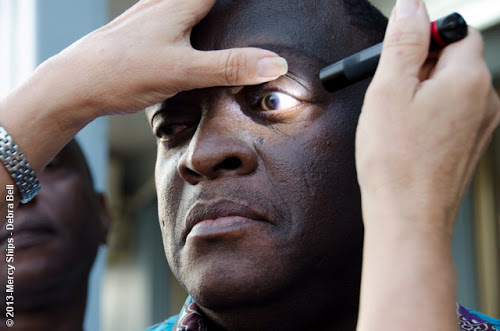Eye Center Andalusia: State-of-the-Art Care for All Ages
Wiki Article
Understanding the Various Vision Correction Procedures Available for Clearer View
In the world of vision modification procedures, a multitude of alternatives exist to attend to refractive errors and provide people with clearer view. From the widely recognized LASIK surgical procedure to less intrusive procedures like PRK and implantable lenses, the field of ophthalmology offers a variety of techniques tailored to fit different demands and preferences. Each treatment includes its very own collection of factors to consider, benefits, and potential threats. Understanding the nuances of these vision improvement techniques is important for making educated decisions about one's aesthetic wellness. Let's discover the complexities of these treatments and dropped light on the course to accomplishing boosted vision clarity.LASIK Surgical Procedure
LASIK surgical treatment is a common refractive procedure utilized to deal with vision problems such as astigmatism, nearsightedness, and farsightedness. This surgical method, which means Laser-Assisted sitting Keratomileusis, intends to improve the cornea to boost just how light is focused on the retina, inevitably enhancing vision clearness. During the treatment, a slim flap is developed on the cornea, and a laser is utilized to eliminate exact quantities of cells to reshape it appropriately. This reshaping permits light to be properly concentrated onto the retina, fixing refractive mistakes.One of the primary advantages of LASIK surgical treatment is the rapid improvement in vision experienced by people. Several people see a significant enhancement in their sight right away after the procedure. In addition, a lot of people report very little pain and discomfort during the surgery and recuperation duration. The recovery time for LASIK is reasonably quick, with many people going back to their daily tasks within a day or more post-operation. Generally, LASIK surgical procedure is a preferred option for people seeking a long-term option for their vision problems.
PRK Treatment

PRK is an ideal alternative for individuals with thin corneas or those at a higher risk of eye injuries, as it does not include developing a corneal flap. The recovery process for PRK is slightly longer compared to LASIK, as the epithelium requires time to restore. Clients may experience pain and blurred vision for a couple of days adhering to the treatment.
In spite of the longer healing time, PRK can generate excellent lead to vision enhancement, making it a valuable alternative for those who may not be suitable candidates for LASIK surgical procedure. - Andalusia Pediatrics
Implantable Lenses
As opposed to PRK where the cornea is reshaped directly, implantable lenses offer another approach for correcting vision by inserting man-made lenses inside the eye. This procedure is particularly useful for people with high degrees of farsightedness, astigmatism, or nearsightedness who may address not appropriate prospects for laser surgeries like LASIK or PRK.Implantable lenses, also called phakic intraocular lenses, job by supplementing the eye's natural lens with a synthetic one. These lenses can be placed before the natural lens (former chamber) or behind the iris and in front of the natural lens (posterior chamber) By readjusting the power and positioning of these lenses, ophthalmologists can efficiently fix refractive errors and boost aesthetic acuity.
One benefit of implantable lenses is that they are exchangeable and detachable, offering adaptability for future changes. Nevertheless, just like any type of operation, there are threats included, such as infection or cataract development. Individuals thinking about implantable lenses should speak with an eye care specialist to establish the most ideal choice based upon their individual needs and eye wellness.
Corneal Rings

The procedure for placing corneal Find Out More rings is minimally intrusive and relatively quick, usually executed as an outpatient treatment. Throughout the surgical procedure, the ophthalmologist makes a little laceration in the cornea and inserts the rings at a specific depth. As soon as in position, the rings help to reshape the cornea, offering a smoother surface for light to enter the eye, which can result in more clear vision.
Corneal rings are considered a reversible procedure, as they can be removed or replaced if necessary. While they might not entirely remove the demand for glasses or call lenses, corneal rings can significantly boost vision top quality and general visual comfort for individuals with keratoconus or various other corneal abnormalities.
Refractive Lens Exchange
Complying with the modification of corneal irregularities with procedures like corneal rings, an additional vision correction strategy that can attend to refractive errors is Refractive Lens Exchange (RLE) RLE is a surgical treatment that includes replacing the eye's natural lens with a fabricated intraocular lens (IOL) to deal with refractive errors such as nearsightedness, farsightedness, and presbyopia. This treatment is specifically helpful for people who might not appropriate prospects for procedures like LASIK or PRK as a result of elements such as slim corneas or high refractive mistakes.Healing time for RLE is reasonably fast, and patients can expect improved vision quickly after the treatment. As with any kind of surgical procedure, prospective threats and problems exist, so a detailed consultation with an eye care professional is vital to establish if RLE is the ideal vision modification option.
Final Thought

In the realm of vision correction treatments, a wide variety of choices exist to address refractive errors and provide people with clearer view.LASIK surgical treatment is a common refractive treatment used to fix vision troubles such as farsightedness, nearsightedness, and astigmatism.While also a typical refractive treatment, the PRK (Photorefractive Keratectomy) method varies from LASIK surgical treatment in its technique to correcting vision troubles.Following the improvement of corneal irregularities with procedures like corneal rings, one more vision adjustment method that can attend to refractive errors is Refractive Lens Exchange (RLE) LASIK surgical treatment, PRK treatment, implantable lenses, corneal rings, and refractive lens exchange are all options that can address different vision concerns.
Report this wiki page